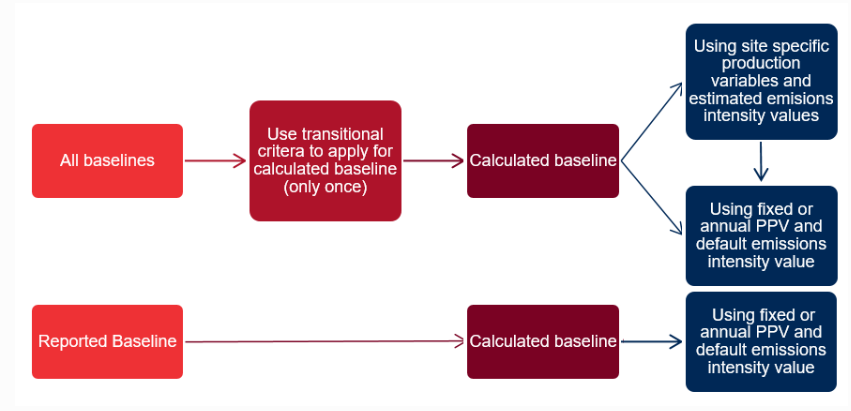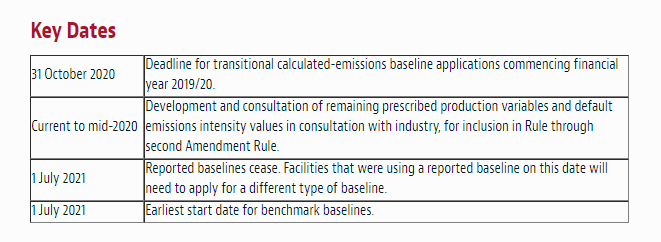Australia: COVID-19 Delays Transition of Safeguard Mechanism Baselines


 Ilona Millar, Partner, together with Lauren Kirkwood, Special Counsel and Guy Dwyer, Senior Associate at Baker & McKenzie, provide a critical update to the transition of safeguard mechanism baselines amidst the ongoing pandemic.
Ilona Millar, Partner, together with Lauren Kirkwood, Special Counsel and Guy Dwyer, Senior Associate at Baker & McKenzie, provide a critical update to the transition of safeguard mechanism baselines amidst the ongoing pandemic.
In brief
On 3 March 2020, the Federal Minister for Energy and Emissions Reduction registered the National Greenhouse and Energy Reporting (Safeguard Mechanism) Amendment (Prescribed Production Variables) Rule 2020 (Cth) (New Rule).
The New Rule inserts government-determined prescribed production variables and default emissions intensity values into the National Greenhouse and Energy Reporting (Safeguard Mechanism) Rule 2015 (Cth) (Principal Rule) to give effect to amendments made to the Principal Rule in March 2019. A summary of the amendments made to the Principal Rule in March 2019 can be found in a previous publication.
In response to COVID-19, the transition period for the New Rule was extended by one year through the National Greenhouse and Energy Reporting (Safeguard Mechanism) Amendment (Extended Transition Rule) 2020 (Cth) (Extended Transition Rule) registered on 6 May 2020.
Key takeaways
The New Rule is important, for the production variables of a facility (that is, the amount of productive output covered by the Safeguard Mechanism) are critical to the determination of different types of baselines for the facility. The New Rule seeks to simplify the application of calculated baselines, and to reduce administrative costs for businesses, by giving facilities the option of electing to use the government-determined prescribed production variables and default emissions-intensity values, instead of site-specific values.
While the New Rule has the effect of enabling many operators of facilities to obtain more generous baseline limits for emissions if their production rates increase, the New Rule has omitted to set default emissions-intensity values for operators in important sectors such as the mining of coal, iron ore and bauxite, or oil and gas production.
The Extended Transition Rule has the effect of delaying many of the changes caused by the New Rule by one year. Importantly, facilities can remain on reported baselines for 2020-21, can continue to be subject to a calculated baseline that expired on 30 June 2019 for the 2019-20 year, and can extend the operation of multi-year period declarations due to expire 30 June 2020 by one year. In addition, the application of benchmark baselines has been pushed back to 1 July 2021.
What the New Rule Does
There are three key things that the New Rule does.
1. Insertion of government-determined prescribed production variables and default emissions-intensity values
The New Rule introduces two types of prescribed production variables into the Principal Rule. They are:
- prescribed production variables that are annually adjusted (which have been introduced into a new Schedule 2 to the Principal Rule) (Annually Adjusted PPVs); and
- prescribed production variables that are fixed (which have been introduced into a new Schedule 3 to the Principal Rule) (Fixed PPVs).
First, Annually Adjusted PPVs are variables that apply to production-adjusted baselines that can be updated annually with production.
Each of the Annually Adjusted PPVs that have been introduced into a new Schedule 2 to the Principal Rule either contains (or is to contain in the future) the following minimum characteristics:
- one or more metrics that each constitute an Annually Adjusted PPV;
- the circumstances in which the metrics are applicable to a facility; and
- the default emissions intensity value for production (which have been set by the Government and represent the industry average emissions intensity of production over five years).
For example, clause 7 of Schedule 2 to the Principal Rule establishes Annually Adjusted PPVs for Aluminium. The metrics specified for Aluminium is:
1. Tonnes of primary aluminium (Al) that:
- has a concentration of aluminium equal to or greater than 98%; and
- is produced as part of carrying on the aluminium smelting activity at the facility; and
- is weighed after electrolysis but before casting.
The clause further establishes that these metrics will apply to a facility that “conducts the activity of aluminium smelting through the physical and chemical transformation of alumina (aluminium oxide (Al2O3) into saleable aluminium metal (Al)”, and that the default emissions intensity value for production is 1.86 t CO2-e per tonne of primary aluminium.
The Annually Adjusted PPVs may also set out, for particular types of facilities:
- the measurement requirements or procedures relevant to application of the metrics (e.g. for facilities in the nature of decommissioned underground mines, the t of CO2-e of emissions must be measured consistently with the NGER (Measurement) Determination); and
- requirements for supporting information to be included in a report under the National Greenhouse and Energy Reporting Act 2007 (Cth) (NGER Act) about the calculation of the amount of the Annually Adjusted PPVs for a financial year.
The emissions relevant to the development of each Annually Adjusted PPV and the calculation of its default emissions intensity are explained in a document titled “Safeguard Mechanism prescribed production variables and default emissions intensities” (Safeguard Mechanism Document) (which is available here).
Secondly, Fixed PPVs are production variables that apply to production-adjusted baselines that are updated once for production and then remain fixed. This type of production variable has been the approach that has been taken to date in terms of application of calculated baselines under the Safeguard Mechanism. Currently, Schedule 3 to the Principal Rule sets out only one type of facility to which the relevant Fixed PPVs may apply, generally being facilities that conduct the activity of petroleum refining. The existing Fixed PPV specified in Schedule 3 to the Principal Rule sets out the same minimum characteristics as those set out above for Annually Adjusted PPVs.
It will be the case that Annually Adjusted PPVs will have much wider relevance and application to the various types of facilities that meet the thresholds set by the Safeguard Mechanism for reporting and accounting of GHG emissions under the NGER Act. Generally speaking, Fixed PPVs are intended to be utilised in circumstances where an appropriate output-based production variable cannot be found, so a proxy needs to be used that is not appropriate for annual adjustment. It may potentially be the case that further Fixed PPVs, other than the existing variables relating to the activity of petroleum refining, may be inserted into Schedule 3 in the future.
Originally, the New Rule allowed all facilities to access a transitional calculated baseline in 2018-19 or 2019-20. The Extended Transition Rule extends this to include 2020-2021 as a response to disruption to business caused by the global COVID-19 pandemic. During this transitional phase, the use of the default emissions intensity values is optional.
Importantly, for facilities with multiple outputs, a combination of default and estimated (site-specific) emissions intensity values can be used. In such cases, it is essential to prevent double-counting of emissions by assigning emissions to only one production variable or apportioning the emissions between two or more production variables.
2. Further guidance on how to prepare an estimated-emissions intensity calculation
The New Rule amends the existing rule 6(8A) in the Principal Rule to provide greater guidance on how to prepare an estimated emissions intensity calculation (EEIC). Previously, rule 6(8A) of the Principal Rule simply provided that, for facilities that utilised both a default emissions-intensity figure and an estimated emissions-intensity figure, the estimated emissions-intensity figure must not include emissions of a kind that were considered in developing the default emissions-intensity figure. While that guidance remains in the Principal Rule (in a renumbered rule 6(8B)), the New Rule providing further guidance on how to prepare an estimated-emissions intensity calculation by specifying that estimated emissions intensity calculations must only include emissions that:
- are of a kind considered in developing the default emissions intensity specified in Schedule 2 or 3 of the Principal Rule (as inserted by the New Rule) (if a default emissions intensity is specified for the particular production variable);
- are of a kind that was considered as relevant to the production variable when it was included in Schedule 2 or 3 of the Principal Rule (as inserted by the New Rule) (if no default emissions intensity is specified for the production variable in Schedule 2 or 3); and
- are minor emissions sources at the facility that:
- were not taken into account in developing a default emissions intensity for another prescribed production variable potentially applicable to the facility;
- were not considered relevant to any prescribed production variable for which a default emissions intensity is not specified in Schedule 2 or 3 of the Principal Rule (as inserted by the New Rule); and
- taken together, are unlikely to exceed 10% of covered emissions of the facility.
In considering particular aspects of the above, regard must be had to the Safeguard Mechanism Document.
3. Amendments to inherent emissions variability criteria
The New Rule amends the existing rule 25(6) in the Principal Rule by providing that the following additional inherent emissions variability criteria:
- no more than one calculated-emissions baseline determination has been made in relation to the facility on the basis that one or more of the following criteria:
- the new facility criteria;
- the significant expansion criteria;
- the inherent emissions variability criteria; and
- the initial calculated baseline criteria.
What the New Rule Does Not Do
One notable omission from the New Rule is the absence to specify, in respect of Annually Adjusted PPVs, default emissions intensity values for many important sectors, including for facilities producing sodium cyanide, run-of-mine coal, iron ore, bauxite, and oil and gas extraction. The default emissions intensity values for facilities in such sectors are subject to ongoing negotiation and consultation between the Commonwealth Government and industry stakeholders. The default value that is ultimately set for such facilities will play an important role in determining the extent of their future GHG emission liabilities.
Analysis
The changes to the Safeguard Mechanism made by the New Rule have the effect of making it easier for existing operators to increase the level of the baseline set for their facilities in circumstances where production activity at the facilities increases.
Potentially, the frameworks introduced by the New Rule may form the basis for subsequent amendments to the Principal Rule to ratchet down the level of baselines set for facilities in all relevant industry sectors so as to better accord with the various GHG emissions targets the Australian Government has set, as well as the objectives of Australia’s Nationally Determined Contribution and the Paris Agreement.
The failure for default emissions intensity values to be set for facilities in important sectors such as oil and gas extraction may be viewed by some stakeholders as disappointing, in that it further prolongs the delay in fully implementing the changes that were contemplated by the March 2019 amendments to the Safeguard Mechanism. It will be interesting to see, in due course, the default emissions intensity values that are ultimately set for such facilities and what considerations informed the development of those values.
It should be recognised that the default values that are currently contained in Schedule 2 and 3 to the Principal Rule (and which are to be inserted in due course for particular facilities) are unlikely to be static, as the Commonwealth Government has foreshadowed that the default values could be changed in the future to reflect, for example, the introduction of new “step-change technologies” or the setting of “new mandated standards” that lead to material changes in the GHG emissions profile for particular industries.
The diagram below outlines the transition to calculated baselines and use of the prescribed production variables and emissions intensity values.


Guy Dwyer is a senior associate in Baker McKenzie’s Sydney office, practising primarily in environmental, planning and climate change law. He is valued by clients for his ability to effectively identify the key environmental and planning law issues arising from a client’s proposed course of action. Guy draws on his deep knowledge and experience in environment and planning matters to communicate advice clearly, timely and in a manner that suits the client. Connect with Guy via email or LinkedIn![]() .
.